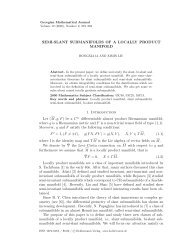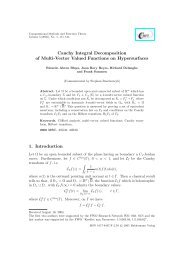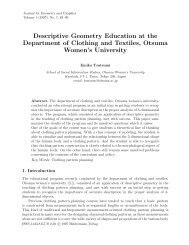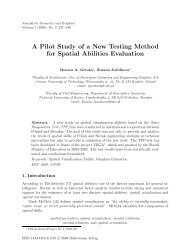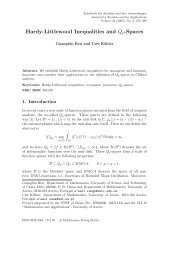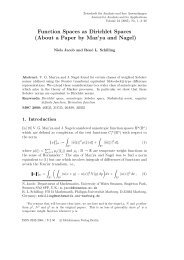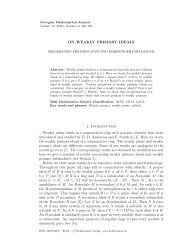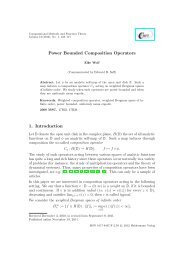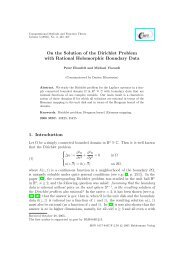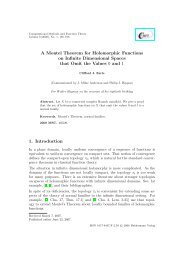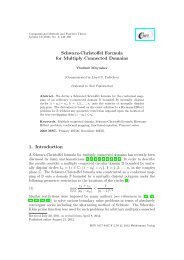Some Power Series Expansions for Monogenic Functions in
Some Power Series Expansions for Monogenic Functions in
Some Power Series Expansions for Monogenic Functions in
Create successful ePaper yourself
Turn your PDF publications into a flip-book with our unique Google optimized e-Paper software.
Computational Methods and Function Theory<br />
Volume 7 (2007), No. 1, 265–275<br />
<strong>Some</strong> <strong>Power</strong> <strong>Series</strong> <strong>Expansions</strong> <strong>for</strong> <strong>Monogenic</strong> <strong>Functions</strong><br />
Dixan Peña Peña and Frank Sommen<br />
(Communicated by Klaus Gürlebeck)<br />
Abstract. New series developments <strong>for</strong> monogenic functions are presented.<br />
The terms of these series have factors that are expressible as power functions<br />
vanish<strong>in</strong>g on special higher codimension submanifolds of Euclidean space.<br />
These series are closely related with the Cauchy-Kowalewski extension problem<br />
as well as to special Vekua systems aris<strong>in</strong>g from the consideration of axial<br />
and biaxial symmetry.<br />
Keywords. Clif<strong>for</strong>d algebras, monogenic functions, Cauchy-Kowalewski extension<br />
problem, Vekua systems.<br />
2000 MSC. 30G35.<br />
1. Introduction<br />
Clif<strong>for</strong>d analysis (see e.g. [2, 6]) offers a function theory which is a higher dimensional<br />
analogue of the theory of the holomorphic functions of one complex<br />
variable. The functions considered are def<strong>in</strong>ed <strong>in</strong> the Euclidean space R m or<br />
R m+1 and take their values <strong>in</strong> the complex Clif<strong>for</strong>d algebra C m .<br />
Consider with<strong>in</strong> this algebra the follow<strong>in</strong>g elliptic differential operator of first<br />
order (generalized Cauchy-Riemann operator)<br />
m∑<br />
∂ x0 + ∂ x = ∂ x0 + e j ∂ xj<br />
where e 1 , . . . , e m are the generat<strong>in</strong>g basic elements of C m . Null solutions of this<br />
operator are called monogenic functions (Clif<strong>for</strong>d holomorphicity).<br />
For the generalized Cauchy-Riemann operator, the computational analogy with<br />
complex variables analysis is worked <strong>in</strong> detail by e.g. Malonek [9, 10].<br />
Received February 2, 2006, <strong>in</strong> revised <strong>for</strong>m November 8, 2006.<br />
Published onl<strong>in</strong>e January 19, 2007.<br />
The first author is supported by a Doctoral Grant of the Special Research Fund of Ghent University<br />
and the second author is supported by the FWO “Krediet aan Navorsers: 1.5.065.04”.<br />
j=1<br />
ISSN 1617-9447/$ 2.50 c○ 2007 Heldermann Verlag
266 D. Peña Peña and F. Sommen CMFT<br />
We must remark that despite the fact that Clif<strong>for</strong>d analysis generalizes the most<br />
important features of classical complex analysis, the monogenic functions do not<br />
enjoy all the properties of the holomorphic functions of one complex variable. For<br />
<strong>in</strong>stance, the product of two monogenic functions is not necessarily monogenic<br />
because of the non-commutativity of the Clif<strong>for</strong>d algebras. It is then natural to<br />
look <strong>for</strong> techniques to construct monogenic functions.<br />
There are a lot of techniques available to generate monogenic functions (a list of<br />
those techniques can be found e.g. <strong>in</strong> [4]). This paper is related with two of these<br />
techniques: the so-called axial monogenic functions and the Cauchy-Kowalewski<br />
extension problem.<br />
Let P k (x) be a homogeneous left monogenic polynomial of degree k <strong>in</strong> R m . The<br />
axial monogenic functions (see [6, 12]) are monogenic functions of the <strong>for</strong>m<br />
(A(x 0 , r) + ω B(x 0 , r)) P k (x), r = |x|, rω = x,<br />
A and B be<strong>in</strong>g scalar functions satisfy<strong>in</strong>g the Vekua-type system<br />
∂ x0 A − ∂ r B = 2k + m − 1 B<br />
r<br />
∂ x0 B + ∂ r A = 0.<br />
For more references on axial monogenic functions and special monogenic functions,<br />
we refer to [8, 14, 15] and <strong>for</strong> the general theory of Vekua systems, we refer<br />
to [1, 17].<br />
The Cauchy-Kowalewski extension problem consists <strong>in</strong> f<strong>in</strong>d<strong>in</strong>g a monogenic extension<br />
g ∗ of a real-analytic function g def<strong>in</strong>ed on a given subset of R m+1 (see<br />
e.g. [2, 3, 5, 6, 7, 11, 13, 16]).<br />
If the given subset is an analytic m-surface <strong>in</strong> R m+1 , then <strong>in</strong> [13] Sommen proved<br />
the existence and uniqueness of such extension. In that paper he improved the<br />
classical Cauchy-Kowalewski extension <strong>for</strong>mula obta<strong>in</strong>ed <strong>in</strong> [2] <strong>for</strong> functions def<strong>in</strong>ed<br />
on the plane {(x 0 , x) ∈ R m+1 : x 0 = 0}. The classical Cauchy-Kowalewski<br />
extension <strong>for</strong>mula is given by the follow<strong>in</strong>g series<br />
∞∑<br />
(1) g ∗ (−x 0 ) k<br />
(x 0 , x) =<br />
∂ k<br />
k!<br />
xg(x).<br />
k=0<br />
The Cauchy-Kowalewski extension problem has not yet been solved <strong>for</strong> surfaces<br />
with higher codimension, except <strong>in</strong> the flat case (see [5, 6]). In this paper we<br />
present possible methods related to solv<strong>in</strong>g this problem <strong>for</strong> special subsets of<br />
R m+1 such as: spheres, cyl<strong>in</strong>ders and planes. Our methods also provide special<br />
solutions of the above mentioned Vekua systems.<br />
2. Prelim<strong>in</strong>aries<br />
Let m ∈ N and let {e 1 , . . . , e m } be an orthonormal basis of R m , then a basis<br />
<strong>for</strong> the Clif<strong>for</strong>d algebra R 0,m or its complexification C m = R 0,m ⊗ C is given by
7 (2007), No. 1 <strong>Some</strong> <strong>Power</strong> <strong>Series</strong> <strong>Expansions</strong> <strong>for</strong> <strong>Monogenic</strong> <strong>Functions</strong> 267<br />
{e A : A ⊆ {1, . . . , m}}, where e ∅ = e 0 = 1 is the identity element, e {j} = e j ,<br />
j = 1, . . . , m and e A = e j1 . . . e jk , A = {j 1 , . . . , j k } be<strong>in</strong>g ordered such that<br />
1 ≤ j 1 < . . . < j k ≤ m. The non-commutative multiplication <strong>in</strong> the Clif<strong>for</strong>d<br />
algebra is governed by the rules:<br />
e j e k + e k e j = −2δ jk , j, k = 1, 2, . . . , m.<br />
Conjugation is def<strong>in</strong>ed as the anti-<strong>in</strong>volution <strong>for</strong> which<br />
e j = −e j , j = 1, 2, . . . , m,<br />
with the additional rule i = −i <strong>in</strong> the case of C m .<br />
For k = 0, 1, . . . , m fixed, we call<br />
⎧<br />
⎨<br />
C (k)<br />
m =<br />
⎩ a ∈ C m : a = ∑<br />
|A|=k<br />
a A e A<br />
⎫<br />
⎬<br />
⎭<br />
the subspace of k-vectors, i.e. the space spanned by the products of k different<br />
basis vectors. The 0-vectors and 1-vectors are simply called scalars and vectors<br />
respectively.<br />
If (x 0 , x 1 , . . . , x m ) ∈ R m+1 is identified with the paravector<br />
m∑<br />
x 0 + x = x 0 + e j x j ,<br />
then R m+1 may be considered as a subspace of R 0,m and C m .<br />
The product of two vectors splits up <strong>in</strong>to a scalar part and a 2-vector or a socalled<br />
bivector part:<br />
x y = x • y + x ∧ y<br />
where<br />
j=1<br />
x • y = −〈x, y〉 = −<br />
m∑<br />
x j y j<br />
j=1<br />
and<br />
x ∧ y = ∑ e j e k (x j y k − x k y j ).<br />
j
268 D. Peña Peña and F. Sommen CMFT<br />
while the generalized Cauchy-Riemann operator D x = ∂ x0 +∂ x splits the Laplace<br />
operator <strong>in</strong> R m+1 ∆ = ∂ 2 x 0<br />
+ ∆ x = (∂ x0 + ∂ x )(∂ x0 − ∂ x ).<br />
A cont<strong>in</strong>uously differentiable C m -valued function g def<strong>in</strong>ed <strong>in</strong> some open set of<br />
R m (R m+1 respectively) satisfy<strong>in</strong>g the equation ∂ x g = 0 (D x g = 0 respectively)<br />
is called a left monogenic function. In what follows we will say “f is monogenic”<br />
rather than “f is left monogenic”.<br />
Pass<strong>in</strong>g to spherical coord<strong>in</strong>ates x = rω, r = |x| and ω ∈ S m−1 , S m−1 be<strong>in</strong>g the<br />
unit sphere <strong>in</strong> R m , we have<br />
(<br />
∂ x = ω ∂ r + 1 )<br />
r Γ x ,<br />
where<br />
Γ x = −x ∧ ∂ x = − ∑ j
7 (2007), No. 1 <strong>Some</strong> <strong>Power</strong> <strong>Series</strong> <strong>Expansions</strong> <strong>for</strong> <strong>Monogenic</strong> <strong>Functions</strong> 269<br />
Theorem 1 (Toroidal expansion of axial type). A sufficient condition <strong>for</strong> f to<br />
be monogenic is given by<br />
A k,l+1 (x 0 , x) = − 1 (<br />
∂ x0 A k,l (x 0 , x) + ω∂ r A k,l (x 0 , x)<br />
2(l + 1)<br />
(m − 1)ω<br />
(3)<br />
+ (A k,l (x 0 , x) − A l,k (x 0 , x))<br />
2r<br />
+ ω )<br />
r Γ xA l,k (x 0 , x) , k, l ≥ 0.<br />
Proof. Let z = x 0 +(r−1)i and put B k,l (x 0 , x) = Z k Z l A k,l (x 0 , x), then B k,l (x 0 , x)<br />
may be written as<br />
There<strong>for</strong>e<br />
B k,l (x 0 , x) = z<br />
l (1 − iω)<br />
k¯z A k,l (x 0 , x) + ¯z k l (1 + iω)<br />
z A k,l (x 0 , x).<br />
2<br />
2<br />
D x B k,l (x 0 , x) = 2lZ k Z l−1 A k,l (x 0 , x)<br />
+Z k Z l (∂ x0 A k,l (x 0 , x) + ω∂ r A k,l (x 0 , x)<br />
+ (m−1)ω )<br />
A k,l (x 0 , x)<br />
2r<br />
(<br />
+Z k ω<br />
Z l r Γ xA k,l (x 0 , x) − (m−1)ω A k,l (x 0 , x)<br />
2r<br />
and the action of the operator D x on f is given by<br />
∞∑ ∞∑<br />
D x f(x 0 , x) = Z k Z<br />
(2(l l + 1)A k,l+1 (x 0 , x) + ∂ x0 A k,l (x 0 , x)<br />
k=0<br />
l=0<br />
+ ω∂ r A k,l (x 0 , x)<br />
(m − 1)ω<br />
+ (A k,l (x 0 , x) − A l,k (x 0 , x))<br />
2r<br />
+ ω )<br />
r Γ xA l,k (x 0 , x) .<br />
Hence we arrive at the conclusion that the recurrence relation (3) is sufficient<br />
<strong>for</strong> f to be monogenic.<br />
Note that the toroidal expansion (2) generates monogenic functions. All one has<br />
to do is start from the sequence of functions {A k,0 } k≥0 (<strong>in</strong>itial condition) and<br />
calculate the functions A k,l via the recurrence <strong>for</strong>mula (3).<br />
)
270 D. Peña Peña and F. Sommen CMFT<br />
An <strong>in</strong>terest<strong>in</strong>g particular case of the toroidal expansion is the case where the<br />
coefficients do not depend on the variable x 0 and satisfy the symmetric relation<br />
A k,l (x) = A l,k (x). With this assumption we can calculate explicitly us<strong>in</strong>g (3) the<br />
coefficients of series (2). Indeed, they are determ<strong>in</strong>ed by the <strong>for</strong>mula<br />
A k,l (x) = (−1)k+l<br />
2 k+l k! l! ∂k+l x A 0,0 (x).<br />
Substitut<strong>in</strong>g the above <strong>in</strong> (2) gives<br />
∞∑ k∑<br />
f(x 0 , x) = Z k−l Z l A k−l,l (x)<br />
=<br />
=<br />
=<br />
k=0<br />
∞∑<br />
k=0<br />
k=0<br />
l=0<br />
(−1) k<br />
2 k k!<br />
k∑<br />
l=0<br />
k!<br />
(k − l)! l! Zk−l Z l ∂ k xA 0,0 (x)<br />
∞∑ (−1) k<br />
2 k k! (Z + Z)k ∂xA k 0,0 (x)<br />
∞∑ (−x 0 ) k<br />
∂ k<br />
k!<br />
xA 0,0 (x)<br />
k=0<br />
which is the classical Cauchy-Kowalewski extension (1).<br />
We can also solve the recurrence <strong>for</strong>mula (3) if the coefficients satisfy the relation<br />
A k,l (x 0 , x) = (−1) k+l A l,k (x 0 , x). In this case we obta<strong>in</strong> that<br />
⎧<br />
(−1)<br />
⎪⎨<br />
l<br />
2<br />
A k,l (x 0 , x) =<br />
k+l k! l! D x(P x D x ) (k+l−1)/2 A 0,0 (x 0 , x) if k + l is odd,<br />
⎪⎩ (−1) l<br />
2 k+l k! l! (P xD x ) (k+l)/2 A 0,0 (x 0 , x) if k + l is even,<br />
where the differential operator P x is def<strong>in</strong>ed by<br />
P x g = ∂ x0 g + ω∂ r g + 1 r Γ x(ωg).<br />
Then we obta<strong>in</strong> the follow<strong>in</strong>g expansion<br />
∞∑ 1<br />
f(x 0 , x) =<br />
2 2k (2k)! (Z − Z)2k (P x D x ) k A 0,0 (x 0 , x)<br />
k=0<br />
∞∑ 1<br />
+<br />
2 2k+1 (2k + 1)! (Z − Z)2k+1 D x (P x D x ) k A 0,0 (x 0 , x)<br />
k=0<br />
∞∑<br />
k (r − 1)2k<br />
= (−1) (P x D x ) k A 0,0 (x 0 , x)<br />
(2k)!<br />
k=0<br />
∞∑<br />
+ (−1) k (r − 1)2k+1 ω<br />
D x (P x D x ) k A 0,0 (x 0 , x).<br />
(2k + 1)!<br />
k=0
7 (2007), No. 1 <strong>Some</strong> <strong>Power</strong> <strong>Series</strong> <strong>Expansions</strong> <strong>for</strong> <strong>Monogenic</strong> <strong>Functions</strong> 271<br />
This expansion may be considered as a k<strong>in</strong>d of Cauchy-Kowalewski extension <strong>for</strong><br />
the cyl<strong>in</strong>der r = 1.<br />
Now we <strong>in</strong>vestigate the generalization of the previous theorem to the biaxially<br />
symmetric case. To that end we split up R m as R m = R p 1<br />
⊕ R p 2<br />
, p 1 + p 2 = m,<br />
yield<strong>in</strong>g<br />
p 1<br />
p<br />
∑<br />
∑ 2<br />
x = x 1 + x 2 , x 1 = e j x j , x 2 =<br />
and accord<strong>in</strong>gly<br />
j=1<br />
j=1<br />
e p1 +jx p1 +j<br />
p 1<br />
p<br />
∑<br />
∑ 2<br />
∂ x = ∂ x1 + ∂ x2 , ∂ x1 = e j ∂ xj , ∂ x2 = e p1 +j∂ . xp1 +j<br />
Introduc<strong>in</strong>g spherical coord<strong>in</strong>ates on R p 1<br />
and R p 2<br />
respectively, i.e.<br />
we thus have that<br />
where<br />
j=1<br />
j=1<br />
x 1 = r 1 ω 1 , r 1 = |x 1 |, ω 1 ∈ S p 1−1<br />
x 2 = r 2 ω 2 , r 2 = |x 2 |, ω 2 ∈ S p 2−1<br />
∂ x = ω 1<br />
(<br />
∂ r1 + 1 r 1<br />
Γ x1<br />
)<br />
+ ω 2<br />
(<br />
∂ r2 + 1 r 2<br />
Γ x2<br />
)<br />
Γ x1 = −x 1 ∧ ∂ x1 and Γ x2 = −x 2 ∧ ∂ x2 .<br />
We call a toroidal expansion of biaxial type a convergent series of biaxial type<br />
around S p1−1 × S p2−1 of the <strong>for</strong>m<br />
∞∑ ∞∑<br />
f(x 1 , x 2 ) = Z k Z l A k,l (x 1 , x 2 ), Z = (r 1 − 1) + (r 2 − 1)ω 1 ω 2 .<br />
k=0<br />
l=0<br />
We thus obta<strong>in</strong> the follow<strong>in</strong>g generalization of Theorem 1.<br />
Theorem 2 (Toroidal expansion of biaxial type). A sufficient condition <strong>for</strong> f<br />
to be monogenic is given by<br />
(<br />
ω<br />
A k+1,l (x 1 , x 2 ) = 1<br />
(ω<br />
2(k + 1) 1 ∂ r1 A k,l (x 1 , x 2 ) + 1 )<br />
Γ x1 A l,k (x<br />
r 1 , x 2 )<br />
1<br />
+ω 2<br />
(∂ r2 A k,l (x 1 , x 2 ) + 1 )<br />
Γ x2 A l,k (x<br />
r 1 , x 2 )<br />
(4)<br />
( 2<br />
(p1 − 1)ω<br />
+<br />
1<br />
+ (p )<br />
2 − 1)ω 2<br />
2r 1 2r 2 )<br />
× (A k,l (x 1 , x 2 ) − A l,k (x 1 , x 2 )) , k, l ≥ 0.
272 D. Peña Peña and F. Sommen CMFT<br />
Proof. Let z = (r 1 − 1) + (r 2 − 1)i and put B k,l (x 1 , x 2 ) = Z k Z l A k,l (x 1 , x 2 ), then<br />
we have that<br />
B k,l (x 1 , x 2 ) = z k¯z l (1 − iω 1ω 2 )<br />
2<br />
There<strong>for</strong>e<br />
∂ x B k,l (x 1 , x 2 ) = 2kZ k−1 Z l ω 1 A k,l (x 1 , x 2 )<br />
A k,l (x 1 , x 2 ) + ¯z k z l (1 + iω 1ω 2 )<br />
A k,l (x<br />
2<br />
1 , x 2 ).<br />
+Z k Z l (ω 1 ∂ r1 A k,l (x 1 , x 2 ) + ω 2 ∂ r2 A k,l (x 1 , x 2 )<br />
( (p1 − 1)ω<br />
+<br />
1<br />
+ (p ) )<br />
2 − 1)ω 2<br />
A k,l (x<br />
2r 1 2r 1 , x 2 )<br />
2<br />
(<br />
+Z k Z l ω 1<br />
Γ x1 A k,l (x<br />
r 1 , x 2 ) + ω 2<br />
Γ x2 A k,l (x<br />
1 r 1 , x 2 )<br />
2<br />
( (p1 − 1)ω<br />
−<br />
1<br />
+ (p ) )<br />
2 − 1)ω 2<br />
A k,l (x<br />
2r 1 2r 1 , x 2 )<br />
2<br />
and the action of the operator ∂ x on f is given by<br />
∂ x f(x 1 , x 2 ) =<br />
∞∑<br />
k=0<br />
∞∑<br />
Z k Z<br />
(2(k l + 1)ω 1 A k+1,l (x 1 , x 2 )<br />
l=0<br />
+ω 1<br />
(∂ r1 A k,l (x 1 , x 2 ) + 1 )<br />
Γ x1 A l,k (x<br />
r 1 , x 2 )<br />
1<br />
+ω 2<br />
(∂ r2 A k,l (x 1 , x 2 ) + 1 )<br />
Γ x2 A l,k (x<br />
r 1 , x 2 )<br />
2<br />
( (p1 − 1)ω<br />
+<br />
1<br />
+ (p )<br />
2 − 1)ω 2<br />
2r 1 2r 2<br />
)<br />
× (A k,l (x 1 , x 2 ) − A l,k (x 1 , x 2 ))<br />
.<br />
We thus have that the recurrence relation (4) is sufficient <strong>for</strong> function f to be<br />
monogenic.<br />
Note that <strong>for</strong> the toroidal expansion of biaxial type the sequence of functions<br />
{A 0,l (x 1 , x 2 )} l≥0 is the <strong>in</strong>itial condition.
7 (2007), No. 1 <strong>Some</strong> <strong>Power</strong> <strong>Series</strong> <strong>Expansions</strong> <strong>for</strong> <strong>Monogenic</strong> <strong>Functions</strong> 273<br />
Let P x1 and P x2 be the differential operators def<strong>in</strong>ed by<br />
P x1 g = ω 1 ∂ r1 g + 1 r 1<br />
Γ x1 (ω 1 g),<br />
P x2 g = ω 2 ∂ r2 g + 1 r 2<br />
Γ x2 (ω 2 g).<br />
In a completely analogous manner as <strong>in</strong> the axial case, us<strong>in</strong>g (4) we obta<strong>in</strong> the follow<strong>in</strong>g<br />
Cauchy-Kowalewski like extensions around S p 1−1 and S p 2−1 respectively.<br />
(i) A k,l (x 1 , x 2 ) = A l,k (x 1 , x 2 ):<br />
∞∑<br />
f(x 1 , x 2 ) = (−1) k (r 1 − 1) 2k ( ) k<br />
(Px1 − ∂ x2 )∂ x A0,0 (x<br />
(2k)!<br />
1 , x 2 )<br />
k=0<br />
∞∑<br />
+ (−1) k (r 1 − 1) 2k+1 ω 1<br />
( ) k<br />
∂ x (Px1 − ∂ x2 )∂ x A0,0 (x<br />
(2k + 1)!<br />
1 , x 2 )<br />
k=0<br />
(ii) A k,l (x 1 , x 2 ) = (−1) k+l A l,k (x 1 , x 2 ):<br />
∞∑ (r 2 − 1) 2k ( ) k<br />
f(x 1 , x 2 ) =<br />
(∂x1 − P x2 )∂ x A0,0 (x<br />
(2k)!<br />
1 , x 2 )<br />
k=0<br />
∞∑ (r 2 − 1) 2k+1 ω<br />
+<br />
2<br />
( ) k<br />
∂ x (∂x1 − P x2 )∂ x A0,0 (x<br />
(2k + 1)!<br />
1 , x 2 ).<br />
k=0<br />
4. Another special expansion<br />
Motivated by both the Cauchy-Kowalewski extension and the Fischer decomposition<br />
(see [6]) we consider the series<br />
∞∑ ∞∑<br />
f(x 0 , x 1 , x 2 ) = (x 0 + x 1 ) k (x 0 − x 1 ) l A k,l (x 0 , x 1 , x 2 ).<br />
k=0<br />
l=0<br />
We are thus led to the follow<strong>in</strong>g theorem.<br />
Theorem 3. Sufficient <strong>for</strong> f to be monogenic is the recurrence relation<br />
A k,l+1 (x 0 , x 1 , x 2 ) = − 1 (<br />
∂ x0 A k,l (x 0 , x<br />
2(l + 1)<br />
1 , x 2 ) + ω 1 ∂ r1 A k,l (x 0 , x 1 , x 2 )<br />
(5)<br />
+ (p 1 − 1)ω 1<br />
2r 1<br />
× (A k,l (x 0 , x 1 , x 2 ) − A l,k (x 0 , x 1 , x 2 ))<br />
+ ω 1<br />
Γ x1 A l,k (x 0 , x<br />
r 1 , x 2 )<br />
1 )<br />
+∂ x2 A l,k (x 0 , x 1 , x 2 ) , k, l ≥ 0.
274 D. Peña Peña and F. Sommen CMFT<br />
Proof. The proof is similar to the proof of Theorem 1.<br />
Let p 1 = 1. For this particular case we can assume that the coefficients <strong>in</strong> the<br />
above series only depend on the variable x 2 (note that x 2 = ∑ m<br />
j=2 x je j ). Then<br />
the recurrence relation (5) takes the <strong>for</strong>m<br />
A k,l+1 (x 2 ) = − 1<br />
2(l + 1) ∂ x 2<br />
A l,k (x 2 ), k, l ≥ 0.<br />
Solv<strong>in</strong>g this recurrence relation we get that<br />
⎧<br />
l (k − l)!<br />
⎪⎨ (−1)<br />
4<br />
A k,l (x 2 ) =<br />
l k! l! ∆l x 2<br />
A k−l,0 (x 2 ) if k ≥ l,<br />
⎪⎩ (−1) k+1 (l − k − 1)!<br />
∂<br />
2 4 k x2 ∆ k x<br />
k! l!<br />
2<br />
A l−k−1,0 (x 2 ) if k < l,<br />
where ∆ x2 = ∑ m<br />
j=2 ∂2 x j<br />
.<br />
We have thus obta<strong>in</strong>ed the follow<strong>in</strong>g codimension 2 generalization of the Cauchy-<br />
Kowalewski Extension Theorem.<br />
Corollary 1. Let A k,0 (x 2 ) (k ≥ 0) be given functions, and consider the <strong>for</strong>mal<br />
series<br />
∞∑ ∞∑<br />
m∑<br />
f(x 0 , x 1 , x 2 ) = (x 0 + e 1 x 1 ) k (x 0 − e 1 x 1 ) l A k,l (x 2 ), x 2 = x j e j .<br />
k=0<br />
l=0<br />
Then there exist unique functions A k,l (x 2 ), k ≥ 0, l > 0, such that the above<br />
sum f is monogenic. Moreover, those functions can be calculated us<strong>in</strong>g the above<br />
<strong>for</strong>mula.<br />
References<br />
1. L. Bers, Theory of Pseudo-Analytic <strong>Functions</strong>, Institute <strong>for</strong> Mathematics and Mechanics,<br />
New York University, New York, 1953.<br />
2. F. Brackx, R. Delanghe and F. Sommen, Clif<strong>for</strong>d Analysis, Research Notes <strong>in</strong> Mathematics,<br />
76, Pitman (Advanced Publish<strong>in</strong>g Program), Boston, 1982.<br />
3. A. K. Common and F. Sommen, Special bi-axial monogenic functions, J. Math. Anal.<br />
Appl. 185 (1994) no.1, 189–206.<br />
4. R. Delanghe, Clif<strong>for</strong>d analysis: history and perspective, Comput. Methods Funct. Theory<br />
1 (2001) no.1, 107–153.<br />
5. R. Delanghe, F. Sommen and V. Souček, Residues <strong>in</strong> Clif<strong>for</strong>d analysis, <strong>in</strong>: Partial Differential<br />
Equations with Complex Analysis, Pitman Res. Notes Math. Ser., 262, Longman<br />
Sci. Tech., Harlow, 1992, 61–92.<br />
6. Clif<strong>for</strong>d Algebra and Sp<strong>in</strong>or-Valued <strong>Functions</strong>, Mathematics and its Applications,<br />
53. Kluwer Academic Publishers Group, Dordrecht, 1992.<br />
7. B. Jancewicz, Harmonic coord<strong>in</strong>ates and the electromagnetic field, <strong>in</strong>: Clif<strong>for</strong>d Algebras<br />
and their Applications <strong>in</strong> Mathematical Physics, Montpellier, 1989, Fund. Theories Phys.,<br />
47, Kluwer Acad. Publ., Dordrecht, 1992, 413–424.<br />
8. P. Lounesto and P. Bergh, Axially symmetric vector fields and their complex potentials,<br />
Complex Variables Theory Appl. 2 (1983) no.2, 139–150.<br />
j=2
7 (2007), No. 1 <strong>Some</strong> <strong>Power</strong> <strong>Series</strong> <strong>Expansions</strong> <strong>for</strong> <strong>Monogenic</strong> <strong>Functions</strong> 275<br />
9. H. Malonek, Hypercomplex differentiability and its applications, <strong>in</strong>: Clif<strong>for</strong>d Algebras<br />
and their Applications <strong>in</strong> Mathematical Physics, De<strong>in</strong>ze, 1993, Fund. Theories Phys., 55,<br />
Kluwer Acad. Publ., Dordrecht, 1993, 141–150.<br />
10. , Contributions to a geometric function theory <strong>in</strong> higher dimensions by Clif<strong>for</strong>d<br />
analysis methods, <strong>in</strong>: <strong>Monogenic</strong> <strong>Functions</strong> and M-Con<strong>for</strong>mal Mapp<strong>in</strong>gs, Clif<strong>for</strong>d analysis<br />
and its applications (Prague, 2000), NATO Sci. Ser. II Math. Phys. Chem., 25, Kluwer<br />
Acad. Publ., Dordrecht, 2001, 213–222.<br />
11. F. Sommen, Hypercomplex Fourier and Laplace trans<strong>for</strong>ms II, Complex Variables Theory<br />
Appl. 1 (1982/83) no.2–3, 209–238.<br />
12. , Plane elliptic systems and monogenic functions <strong>in</strong> symmetric doma<strong>in</strong>s, Rend. Circ.<br />
Mat. Palermo 2 (1984) no.6, 259–269.<br />
13. , <strong>Monogenic</strong> functions on surfaces, J. Re<strong>in</strong>e Angew. Math. 361 (1985), 145–161.<br />
14. , Special functions <strong>in</strong> Clif<strong>for</strong>d analysis and axial symmetry, J. Math. Anal. Appl.<br />
130 (1988) no.1, 110–133.<br />
15. , On a generalization of Fueter’s theorem, Z. Anal. Anwendungen 19 (2000) no.4,<br />
899–902.<br />
16. F. Sommen and B. Jancewicz, Explicit solutions of the <strong>in</strong>homogeneous Dirac equation, J.<br />
Anal. Math. 71 (1997), 59–74.<br />
17. I. N. Vekua, Generalized Analytic <strong>Functions</strong>, Pergamon Press, London, 1962.<br />
Dixan Peña Peña<br />
E-mail: dixan@cage.UGent.be<br />
Address: Ghent University, Department of Mathematical Analysis, Galglaan 2, B-9000 Gent,<br />
Belgium.<br />
Frank Sommen<br />
E-mail: fs@cage.UGent.be<br />
Address: Ghent University, Department of Mathematical Analysis, Galglaan 2, B-9000 Gent,<br />
Belgium.



